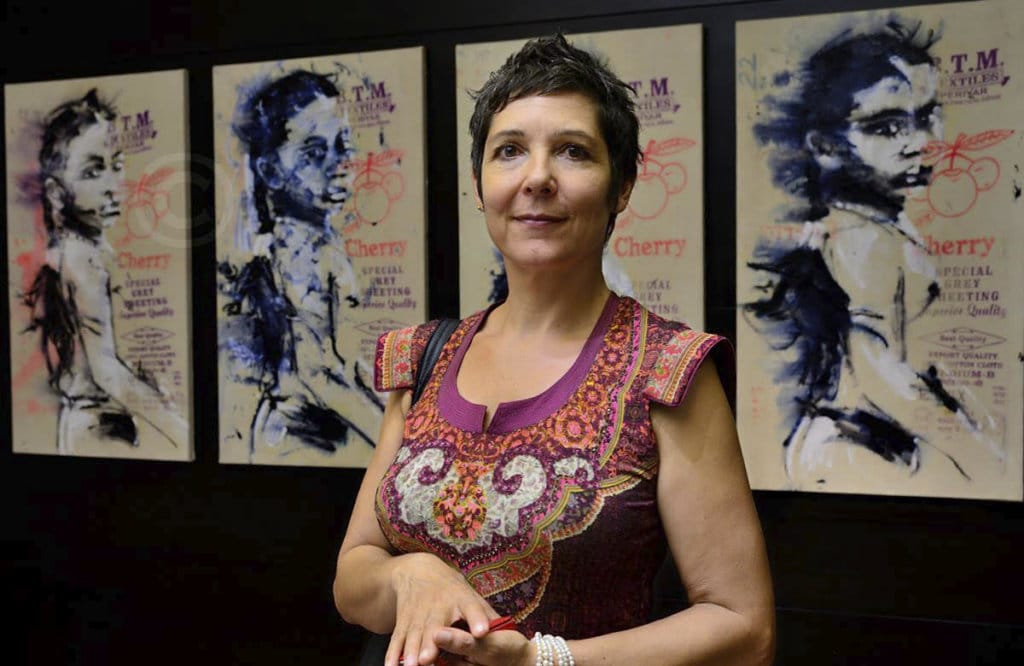Béatrice de Fays first came to India in 2006 after she was awarded the “Villa Medicis Hors les Murs” scholarship by the French government.
“It is a prestigious scholarship that allows artists to go abroad to discover the culture of a different country and showcase it through art. The French Embassy in India, Alliance Française and other local partners support the artists throughout their stay,” she tells Little India.
The Franco-Belgian artist, who spent most of her life in Paris and Angouleme, has been working on paintings and multimedia installations for the last 34 years.
From 2006 to 2013, Béatrice de Fays kept shuttling between India and France for work, before moving to Hyderabad to set up her own studio.
The self-taught artist spoke to Little India about her life and experiences in India:
Working in India
Before coming to India, I found that my family already had links with the country. A painter close to my family in the 18th century loved India and Ceylon. He would paint and write about those countries and also had a big Indian art collection in Brussels. When I was young, I was really moved by some of the statues of Buddha.
After I won the scholarship, I decided to come to India and, with the support of the French embassy here, I was able to present an interactive installation at the Srishti School of Art in Bengaluru, the Indian Institute of Technology Bombay, and Kalahita Art Gallery in Hyderabad.
Artist Béatrice de Fays at a multimedia installation at Park Hyatt Hyderabad. Photo: Sinardhan
The Kalahita Art Gallery then invited me for a four-month residence to create and exhibit some paintings. I kept coming back to the country after that and eventually set up my company in Puducherry. I held several exhibitions and also sold paintings, several of which were 20 meters long (comprising over 300 paintings), to Park Hyatt Hyderabad for their contemporary art collection.
In 2013, I installed my personal studio in Hyderabad.
Everyday Challenges
I had decided long ago in life that I wouldn’t own a car. It was easy to walk, cycle or use the public transport in Paris. But it is much more difficult in India. It is quite dangerous to walk on the streets here. Besides that, the way people look or stare at foreigners is something difficult to deal with on a daily basis.
Auto-rickshaws exploit foreigners by charging them 10 times the normal price. The public transport system is not well developed either. Cabs are also not available during rush hours or monsoon. The pollution levels are high. During the winter season, I have to wear a mask and go out.
Life in Hyderabad
The infrastructure here is laid out differently. There is no desire for beauty. Only money and power seems to work.
I enjoyed the close proximity to the sea and nature when I lived in Puducherry for a few months in 2011-12. Also, the dressing there is a lot freer than in Hyderabad. I like to wear anarkali kurtas that come from the ancient and beautiful Persian culture of India. I also like the simplicity of a lungi. It’s a shame that Indian women cannot wear it. The sari can be beautiful if worn properly.
Social Conditioning
There are a lot of limitations placed on people here due to the education system, tradition, culture, religion and the general environment within the society. As a result, they tend to overplay their lives rather than live it. You need to get rid of what you have been conditioned to believe so that you can evolve or grow as responsible individuals. This concerns all societies in the world, but is quite noticeable in India.
Béatrice de Fays photographs little girls in the old city of Hyderabad. Photo: Serish Nanisetti
Paradoxically, this society has also allowed people to just be who they are. As a foreigner, I like the fact that I have the freedom to express myself. Being from a different country helps me be a privileged observer of the different worlds that make the society here.
I wonder why the Indian society is attracted by materialism. Having said that, I have also come across people who have been able to search for truth within themselves and shift from materialism to an abstract world. I love spirituality, unconventional wisdom and a certain freedom that still emanates among some Indians today.
Desire to Reconnect
When I first came here, I used to work only on multimedia installations and was not painting anymore. However, when I saw the red earth in Auroville, I felt a strong desire to paint again. Since then, I have been doing both painting and multimedia installations in an attempt to reconnect the digital and the material worlds.
Art in India is different from what I know and that is what enables me to go beyond my own limits as an artist. We are always influenced by what surrounds us, especially what affects us within. We are all humans looking for happiness, love and peace. Everyone experiences life in a different way. It is these similarities and differences that enable a rich and real interaction.
People evolve and grow with time. I did as well and continue to do so. My experiences in India assured me that I was growing in the right direction. India taught me to take life as it comes.
The interview has been condensed and edited.
Expat Voice is regular column on expats in India. Email us at expat@littleindia.com to nominate yourself or another expat for the column.
